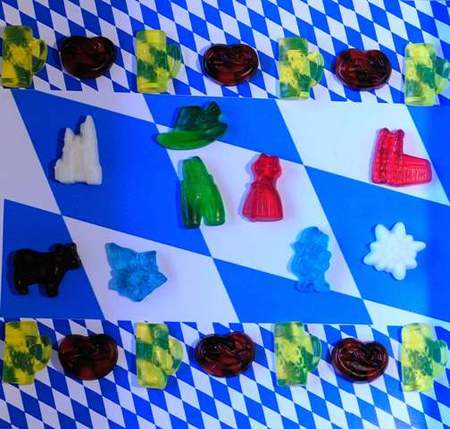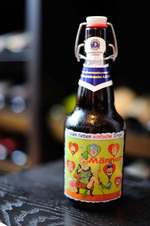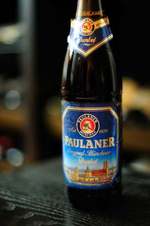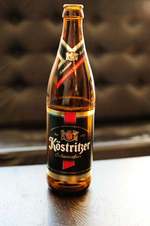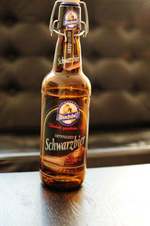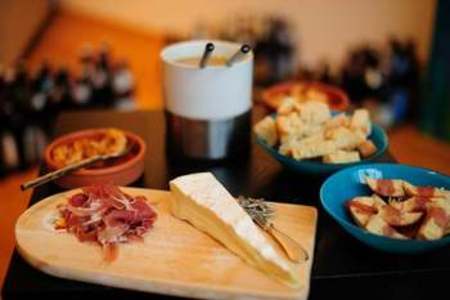Entries in Food, Cooking, & Dining (67)
German Beer Wars - Round 1
 Thursday, September 23, 2010 at 12:47
Thursday, September 23, 2010 at 12:47 It turns out that choosing the beers was the easy part…pairing beer and food takes a bit more thought. Not as easy as wine and food…
For our first round, we went with pairs of Schwarzbier and Dunkelbier. Both are dark and much more malty than hoppy, and my first thought was cheese. A dark beer need some cream and fat to stand up to it and bring out the flavors.
So, inspired by The German Beer Institute and the discovery of the beautiful cheese selection at my local Manufactum (English / German), I went with a Schwarzbier Cheese Fondue, garlic shrimp tapas, brie, and prosciutto. For dipping, we used toasted french bread and ham-wrapped toast.
And the surprising winner was Paulaner Original Münchener Dunkel. Surprising, because we expected one of the smaller breweries to have a superior beer. But Paulaner pulled through to the Sweet Sixteen with a very balanced and tasty Dunkelbier. The Flensburger was nice, but had a strong, single flavor. The Paulaner had a much more complex, but perfectly balanced, blend of various flavors. It's extremely drinkable!
Both Schwarzbiers were good, with the Mönchshof having a slightly more aggressive taste. Schwarzbier overall was a good discovery - I plan on cooking with it in the future and enjoying the extra!
Recipes:
Schwarzbier Fondue Recipe:
12 oz. / 355 mL Schwarzbier
12 oz. (4 cups) / 450g mix of shredded cheese (recommend Gruyere and Emmenthaler)
2 Tbsp / 12-15g flour (substitute cornstarch for gluten free)
A pinch each of ground nutmeg, black pepper, and cloves
1 Tbsp Kirsch or Vodka (optional)
Heat beer in pot. Coat shredded cheese in flour (using a large Ziploc bag is easiest). Gradually add floured cheese to the beer, stirring constantly until cheese just melts. (Don’t let it get too hot, or the cheese will ball up.) Stir in spices and (optional) Kirsch. Transfer to fondue pot for warming and serving.
Make sure not to let the mixture cool too much before serving or the cheese may become stringy.
Serve with toasted bread cubes, crackers, breadsticks, or Ham-Wrapped Toast.
Ham-Wrapped Toast: (Herr J’s invention)
Good quality bread (french, seven grain, and ciabatta work well)
Dry-cured ham, such as proscuitto or serrano
Manchego cheese (optional)
Cut bread into bite-sized rectangles and lightly toast in oven (top with thin slices of manchego before toasting, if using). Take out and wrap each toast piece across the middle with a strip of ham. Return to oven and toast until ham is warmed and bread edges are crisp.
 Frau A ...
Frau A ...  3 Comments
3 Comments  Beer,
Beer,  Food, Cooking, & Dining tagged
Food, Cooking, & Dining tagged  beer,
beer,  beer tournament ...
beer tournament ...  Print Article
Print Article  Email Article
Email Article  Share Article
Share Article Gummi Bears
 Thursday, September 23, 2010 at 8:31
Thursday, September 23, 2010 at 8:31 After beer and cars, gummi bears are one of Germany’s biggest contributions to the world. Einstein and Martin Luther were pretty influential too, but everyone loves Hans Riegel and his little Gold Bears!
They’re everywhere – bears instead of mints at restaurants, blue peppermint gummi bears on my pillow in a hotel, and reportedly free in the German parliament’s cafeteria (legend has it Konrad Adenauer was never without them).
You can find Trolli and HARIBO (founded by Hans Riegel from Bonn, Germany) brands in most food stores, but there are many dedicated gummi bear stores. They come in every shape and flavor, even wine gummis, prosecco gummis, vegetarian and halal, sugar-free, and vitamin-packed gummis for the kiddos. Something for everyone...
I live above Bears and Friends. They specialize in gummis made in Bavaria from select ingredients, with real fruit juice and no artificial dyes. Both the “made in Bavaria” and the natural ingredients aspects go a long way here, but those are topics for another day...
Animal, vegetable, mineral – they have it all. Even some NSFW gummis, two words I didn’t expect to hear together. For now I’ll leave you with the Sea Creature Gummis. The sharks were really tasty!
 Frau A ...
Frau A ...  2 Comments
2 Comments  Food, Cooking, & Dining,
Food, Cooking, & Dining,  Gummi Art tagged
Gummi Art tagged  gummi art ...
gummi art ...  Print Article
Print Article  Email Article
Email Article  Share Article
Share Article Kitchen Calculus
 Thursday, September 16, 2010 at 21:34
Thursday, September 16, 2010 at 21:34 Well, I haven’t gone so far as to calculate rates of change and to-the-millisecond time to cook eggs at different altitudes (there’s a best-selling German iPhone app for that, plus I hate hate HATE eggs), but I’m shocked how much math I use in the kitchen!
Herr J laughs at my cooking using calculator, scale, charts, and tape measure. The tape measure doesn’t get too much use, but the calculator gets a real workout. Even simple cooking is a bit of an adventure….the recipes are usually in American, the ingredients sold in metric, and the oven in Celsius. Or the recipes are really large and I want to make a smaller amount. For even more fun, most European recipes measure by weight; American by volume. For pastry and such things requiring precise ratios or relying on chemical reactions, this is a must. But beyond those, it seems one more example of the need to be as exact as possible (link to article on precision). Whatever the reason, I’m a convert. My trusty kitchen scale shows grams and ounces, and I love it!
My first macaron attempt nearly ended upon reading the first ingredient....“900g of egg whites, how the $%@# do I know how many eggs that is??!”. But the dream of tasty macaron-y goodness won me over, and instead I bought a dozen eggs and a scale. And after cracking about 10 of them and not being even close to 900g, out came the calculator to reduce the recipe. Problem solved, and shockingly tasty and pretty salted caramel macarons.
I finally resorted to just taping a chart to the backsplash behind the stove. I still need the calculator, but at least I don’t have to run to the computer to look up how many mL to an ounce to a cup and F° to C°. The Smart Baker is selling useful aprons or towels with common kitchen conversions. Great idea, but there are no metric conversions.
I’m off to buy an apron and a Sharpie…..
 Frau A ...
Frau A ...  3 Comments
3 Comments  Food, Cooking, & Dining,
Food, Cooking, & Dining,  Technology & Design tagged
Technology & Design tagged  cooking,
cooking,  iThingys ...
iThingys ...  Print Article
Print Article  Email Article
Email Article  Share Article
Share Article 



